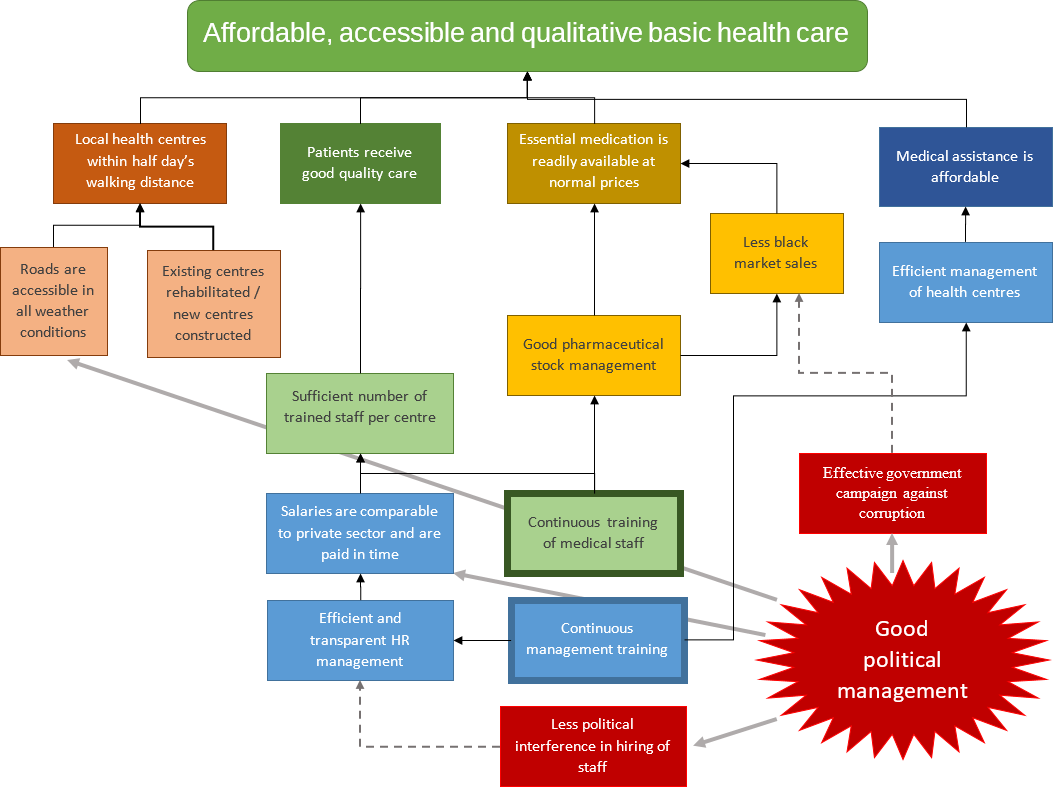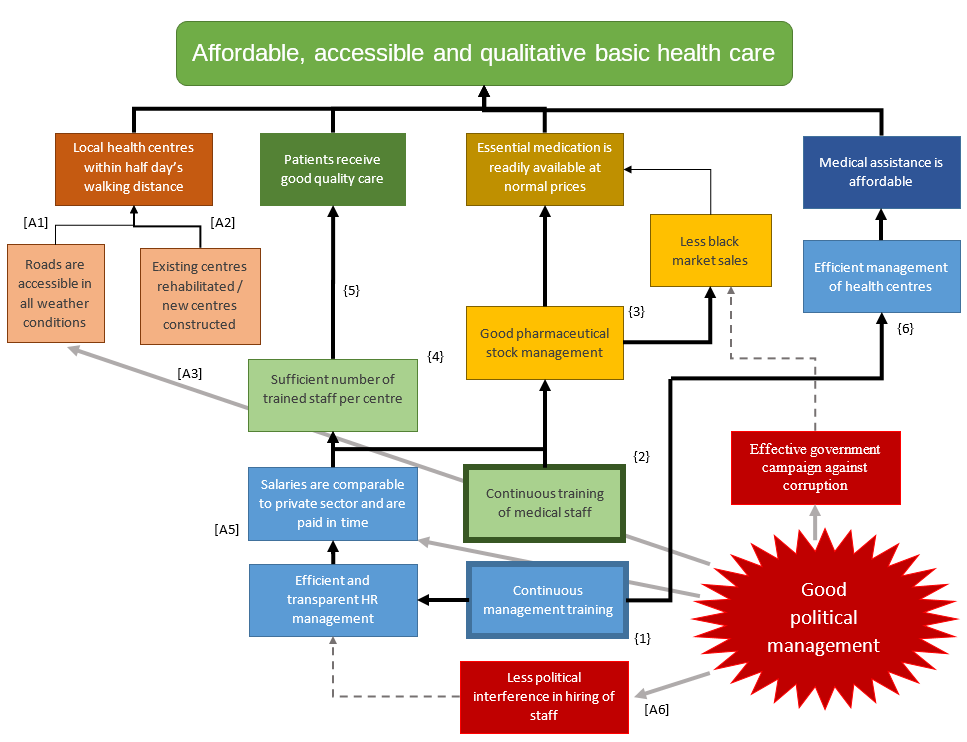3. Develop a conceptual pathway – the Theory of Action
Once it’s clear how change could happen within a certain context – the Theory of Change – it’s time to identify what you as an organisation are going to do to support that change: the Theory of Action.
Some manuals describe the following steps as something you do with your own team. However if you really want a solid ToC it’s much better to see this as a participatory exercise. Seek the involvement of different partners and stakeholders (including potential beneficiaries). Find a good facilitator, organise one or more workshops and allow for discussion (rather than sending documents around by email).
A] Identify long term goal(s)
The first step in developing the pathway to change is to identify the change that you want to achieve. This is your long-term goal. It is a vision of success that you create together with your staff and other stakeholders. But this vision is not just a beautiful dream: it has to be firmly grounded in reality. It has to describe real people, real situations, real cultures, real organisations, etc. It has to be plausible, not some kind of utopia.
You can have more than one long term goal, but if you have more than one goal you will quickly end up with a very large number of outcomes that all have their relations and assumptions and you will end up with a big giant ToC that no-one understands (so KISS: Keep It Simple, Stupid).
To clarify this vision or long term goal, you can describe what the desired change in behaviours, attitudes, capabilities, values and/or relationships will be.
Because the situation in which you work changes over time, your vision also has to by dynamic. This means that working together with other key actors you will need to solve new problems that occur and modify your approach were necessary.
B] Mapping and connecting outcomes (conditions)
The next step is to identify the key changes that are needed to achieve this goal. This is sometimes called mapping. The key changes are the conditions (or outcomes) that must be in place for the change to occur. Explain for each condition/outcome why it is necessary to achieve the goal(s).
These outcomes are not separated building blocks: they can have all sorts of relationships between them, which you must identify. For one thing, it will take more or less time to achieve certain outcomes. That is why the technique of backwards mapping is often used: starting from the final goal(s) you can identify the long term outcomes, then the intermediate outcomes and finally the early term outcomes.

Make sure that you identify the changes that must take place to achieve the long term goal(s). Don’t lose yourself in a wish-list of ‘nice-to-have’ changes but focus on outcomes that are essential for long-term success and on the main topic. Resist the temptation to include all kinds of related topics and to try and solve any kind of problem that you encounter in a given setting or context.
Through this process you will get an overview (or chart) with the outcomes and their connections, which is called the Pathway of Change (or Conceptual Pathway). You will probably start with a first draft that you’ll refine gradually, so this is kind of a gradual process. And even later on when you’re already executing your vision you will need to update the pathway of change.
Once you have this overview, it’s also important to think about who can do what. More often than not your organisation will not be able to achieve all the outcomes on its own. So who can contribute to these outcomes? And how can we collaborate with others to achieve the final goal(s)?
C] Identify possible interventions/activities
Once all the outcomes and their relations have been identified, you can reflect on what activities, approaches or interventions are needed to achieve each outcome. At this stage it is more about the type of activity or intervention; there is no need to go into detailed planning of interventions yet.
However it is important to get to clearly defined outcomes at this stage:
- What does success look like? On what scale will you be working (national, regional, local)? You have to specify the range and scope. Success may have a material form, but more often than not it is a question of people. This means that success may not be physically tangible but that it may be a question of changed behaviours, attitudes, beliefs, values, etc.
- Who is the target population? Whose situation will change when this outcome is achieved? Who will benefit from the intervention(s)? Who are the key constituents?
- What is the expected timeframe? This depends on the time it will take to for the intervention to achieve the desired change, but also on the relation between each outcome and possible others. It may well be that other outcomes must be achieved before this one.
- What amount of change is necessary for success? More often than not this is not a simple yes/no or all-or-nothing answer. If the desired outcome is that the women of a region or country are literate (with the goal of reducing discrimination against women for instance), how many women have to be trained before you have a critical mass that is sufficiently large to speak of success (and sustainability)? Ten women is clearly not enough, but even in the most developed nations there is never 100% literacy. Here the reflection is not so much about numbers (that is what indicators are for and we’ll get back to that) but more about how the (durable) change will look like that a programme should be able to achieve.
This process will give you a first version of a diagram or map with the outcomes, activities and their relations. As explained before you’ll have to go through several cycles of refinement, revision and adaptation with different stakeholders to get to a final version.

In the ToC example above, the contribution of the organisation to the overall change process is marked with the thick black arrows. In the middle, the main intervention strategies are in the boxes with the thick edges: 'Continuous training of medical staff' and 'Continuous management' training respectively. The main assumption here is 'Good political management' which will have to reduce political meddling in nominations of doctors and other medical staff and create a real motivation to work on infrastructure, fight corruption and so on. This assumption must be elaborated and clarified in the next step.
The main purpose of this diagram is that it provides a good and understandable overview of your Theory of Change. You can use all kinds of visual aids (colours, pictograms, arrows…) to accomplish this. And yes, in some cases your ToC will resemble a certain figure and you can emphasise this and release your inner creative person. But don’t force it, don’t make the message secondary to the artwork and don’t simplify too much or modify the content to fit into your beautiful artwork.
In your narrative document, it’s important to explain the rationale of your ToC: why are the different outcomes needed to achieve the overall goal and why will the different interventions lead to the achievement of the outcomes and final goal(s)?